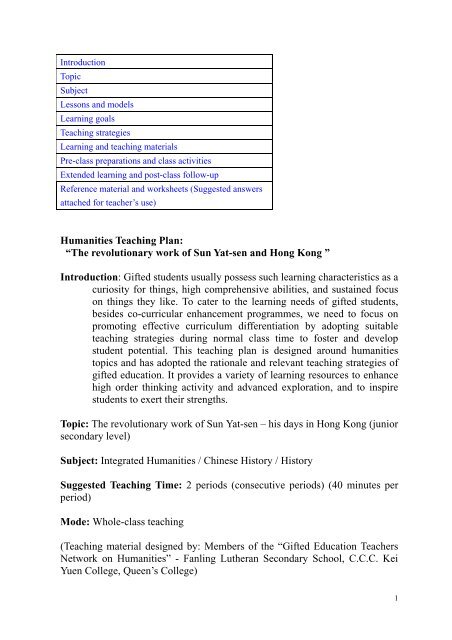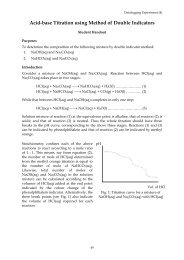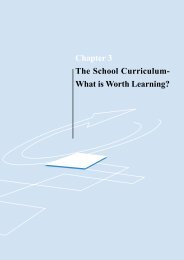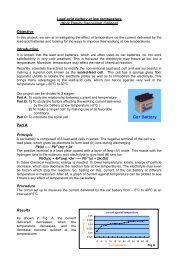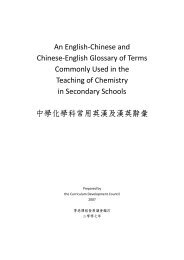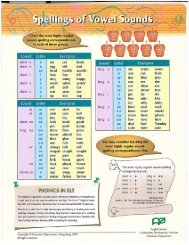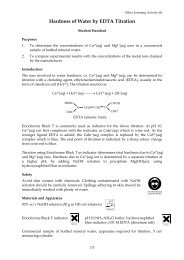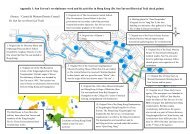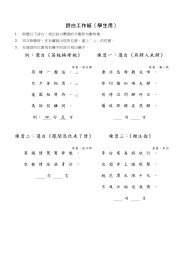The revolutionary work of Sun Yat-sen and Hong Kong
The revolutionary work of Sun Yat-sen and Hong Kong
The revolutionary work of Sun Yat-sen and Hong Kong
You also want an ePaper? Increase the reach of your titles
YUMPU automatically turns print PDFs into web optimized ePapers that Google loves.
IntroductionTopicSubjectLessons <strong>and</strong> modelsLearning goalsTeaching strategiesLearning <strong>and</strong> teaching materialsPre-class preparations <strong>and</strong> class activitiesExtended learning <strong>and</strong> post-class follow-upReference material <strong>and</strong> <strong>work</strong>sheets (Suggested answersattached for teacher’s use)Humanities Teaching Plan:“<strong>The</strong> <strong>revolutionary</strong> <strong>work</strong> <strong>of</strong> <strong>Sun</strong> <strong>Yat</strong>-<strong>sen</strong> <strong>and</strong> <strong>Hong</strong> <strong>Kong</strong> ”Introduction: Gifted students usually possess such learning characteristics as acuriosity for things, high comprehensive abilities, <strong>and</strong> sustained focuson things they like. To cater to the learning needs <strong>of</strong> gifted students,besides co-curricular enhancement programmes, we need to focus onpromoting effective curriculum differentiation by adopting suitableteaching strategies during normal class time to foster <strong>and</strong> developstudent potential. This teaching plan is designed around humanitiestopics <strong>and</strong> has adopted the rationale <strong>and</strong> relevant teaching strategies <strong>of</strong>gifted education. It provides a variety <strong>of</strong> learning resources to enhancehigh order thinking activity <strong>and</strong> advanced exploration, <strong>and</strong> to inspirestudents to exert their strengths.Topic: <strong>The</strong> <strong>revolutionary</strong> <strong>work</strong> <strong>of</strong> <strong>Sun</strong> <strong>Yat</strong>-<strong>sen</strong> – his days in <strong>Hong</strong> <strong>Kong</strong> (juniorsecondary level)Subject: Integrated Humanities / Chinese History / HistorySuggested Teaching Time: 2 periods (consecutive periods) (40 minutes perperiod)Mode: Whole-class teaching(Teaching material designed by: Members <strong>of</strong> the “Gifted Education TeachersNet<strong>work</strong> on Humanities” - Fanling Lutheran Secondary School, C.C.C. KeiYuen College, Queen’s College)1
Learning Objectives:• Learning about the <strong>revolutionary</strong> <strong>work</strong> <strong>of</strong> <strong>Sun</strong> <strong>Yat</strong>-<strong>sen</strong> <strong>and</strong> how it is relatedto <strong>Hong</strong> <strong>Kong</strong>• Developing students’ communication <strong>and</strong> critical thinking abilities• Helping high ability students further develop their learning potentialTeaching Strategies:• Providing a variety <strong>of</strong> learning materials to inspire students explore <strong>Sun</strong><strong>Yat</strong>-<strong>sen</strong>’s experience <strong>and</strong> <strong>revolutionary</strong> <strong>work</strong>s in <strong>Hong</strong> <strong>Kong</strong> from differentperspectives <strong>and</strong> levels, <strong>and</strong> to raise the challenges <strong>of</strong> the learning processthrough advanced <strong>and</strong> extended learning activities, guiding students t<strong>of</strong>urther analyse the role <strong>of</strong> <strong>Hong</strong> <strong>Kong</strong> during <strong>Sun</strong> <strong>Yat</strong>-<strong>sen</strong>’s <strong>revolutionary</strong><strong>work</strong>.• Through Jigsaw Reading, students are encouraged to think <strong>and</strong> share theirlearning, <strong>and</strong> to raise their analytical, integrative, inductive <strong>and</strong> criticalabilities through cooperative learningTeaching <strong>and</strong> Learning Materials:ContentPre-classreadings/assignmentsAppendix 1:(reading material <strong>and</strong> preparatory<strong>work</strong>sheet)<strong>Sun</strong> <strong>Yat</strong>-<strong>sen</strong>’s <strong>revolutionary</strong> <strong>work</strong> <strong>and</strong> hisactivities in <strong>Hong</strong> <strong>Kong</strong>Appendix 2: (Mind map)<strong>Sun</strong> <strong>Yat</strong>-<strong>sen</strong>’s experiences in <strong>Hong</strong> <strong>Kong</strong>Appendix 3:(Reading material with <strong>work</strong>sheet)<strong>Hong</strong> <strong>Kong</strong> population census betweenmid 19 th century <strong>and</strong> early 20 th centuryAppendix 4:(Reading material with <strong>work</strong>sheet)<strong>The</strong> economic prowess <strong>of</strong> <strong>Hong</strong> <strong>Kong</strong>Chinese from late 19 th Century to early20 th centuryAppendix 5:(Map with <strong>work</strong>sheet)<strong>Hong</strong> <strong>Kong</strong>’s geographical locationClassJigsawReadingMaterialClassadvancedlearning(Comprehension/Analysis)After-classextendedlearningReferencematerialsforteachers2
Appendix 6:(Reading material with <strong>work</strong>sheet)Publication industry in <strong>Hong</strong> <strong>Kong</strong> inthe early 20 th centuryAppendix 7:(Reading material with <strong>work</strong>sheet)<strong>Sun</strong> <strong>Yat</strong>-<strong>sen</strong>’s views about <strong>Hong</strong> <strong>Kong</strong>Appendix 8: (Mind map)<strong>The</strong> conditions that enabled <strong>Hong</strong> <strong>Kong</strong>to become a base <strong>of</strong> revolution(Objective factors <strong>and</strong> <strong>Sun</strong> <strong>Yat</strong>-<strong>sen</strong>’spersonal opinions) <strong>and</strong> <strong>Hong</strong> <strong>Kong</strong>’srole in the revolutionAppendix 9:Reference material/Bibliography(Synthesis/Evaluation/Induction/Conclusion)Pre-class Preparations:1. Teacher guides students to read or review individually an essay from thesecondary one Chinese subject: Mr. <strong>Yat</strong>-Sen’s Days as a Medical Student(《 中 山 先 生 的 習 醫 時 代 》);2. Teacher guides students to read individually appendix 1: <strong>Sun</strong> <strong>Yat</strong>-<strong>sen</strong>’s<strong>revolutionary</strong> <strong>work</strong> <strong>and</strong> his activities in <strong>Hong</strong> <strong>Kong</strong>. Students completepre-class preparatory <strong>work</strong>sheets individually3. Teacher divides students into groups <strong>of</strong> 4.Class Activity:Topic/Issue: Why had <strong>Sun</strong> <strong>Yat</strong>-<strong>sen</strong> cho<strong>sen</strong> <strong>Hong</strong> <strong>Kong</strong> as the base for startingthe revolution?Relevant concepts: Subjective factors/objective factors/political factors/social factors/economic factors/geographical factorsQuestionsforenquiryWhy has <strong>Sun</strong><strong>Yat</strong>-<strong>sen</strong>’soverthrowing<strong>of</strong> the QingDynasty in1911 beencalled aLearningmaterialsLearning activities<strong>and</strong> objectivesLead-inQuestion: What is “revolution”? Why has <strong>Sun</strong> <strong>Yat</strong>-<strong>sen</strong>’soverthrowing <strong>of</strong> theQing Dynasty in 1911been called aGifted educationelements/Differentiationteaching strategiesInspire high order thinking instudents using open-endedquestions3
“revolution”?(5 minutes)Whatexperienceshas <strong>Sun</strong><strong>Yat</strong>-<strong>sen</strong>gained in<strong>Hong</strong> <strong>Kong</strong>?(5 minutes)Appendix 1:Readingmaterial withpreparatory<strong>work</strong>sheets,matching thehistorical spotson Dr. <strong>Sun</strong><strong>Yat</strong>-<strong>sen</strong>Historical Trail“revolution”? After the QingDynasty has beenoverthrown, how hasChina’s politicalsystem been changed?Through questioning,teachers guide students intograspingthemeaning/concept <strong>of</strong>“revolution”Follow up on preparations:Students completepreparations before class.<strong>The</strong> teacher, through writingon the blackboard orPowerPoint, guides studentsto share <strong>and</strong> discuss thequestions in the <strong>work</strong>sheet,<strong>and</strong> gain knowledge <strong>of</strong> thesites <strong>of</strong> the Dr. <strong>Sun</strong> <strong>Yat</strong>-<strong>sen</strong>Historical Trail (includingschools that <strong>Sun</strong> <strong>Yat</strong>-<strong>sen</strong>studied in <strong>and</strong> theconference locations wherehe <strong>and</strong> his comradesplanned the revolution)Cultivating self-learningabilities in students;preparation <strong>work</strong>sheets alsoserves as “pre-testing tool” tohelp identify high abilitystudents.(5 minutes) Appendix 2:A mind maplisting<strong>Sun</strong><strong>Yat</strong>-<strong>sen</strong>’sexperiences in<strong>Hong</strong> <strong>Kong</strong>What quality<strong>of</strong> <strong>Hong</strong><strong>Kong</strong> wasconducive topromotingtherevolution?(25 minutes)Appendix 3 to6:Readingmaterial <strong>and</strong><strong>work</strong>sheet,analysing thepolitical,social,economic <strong>and</strong>geographicalsituation <strong>of</strong><strong>Hong</strong> <strong>Kong</strong> inthe past.Advanced questions afterpreparations:<strong>The</strong> teacher, through writingon the blackboard orPowerPoint, guides studentsto apply what they havelearnt through preparation<strong>and</strong> complete the mind map.Jigsaw Reading Teacher dividesstudents into roughlygroups <strong>of</strong> 4 Each group is given 4different sets <strong>of</strong>reading materials with<strong>work</strong>sheets (Appendix3, 4, 5, 6) Each group member isgiven a learning task:read carefully <strong>and</strong>share one set <strong>of</strong>Guide students to furtheridentify the <strong>revolutionary</strong>activities that lead to thedownfall <strong>of</strong> the QingGovernment from the eventsthat <strong>Sun</strong> <strong>Yat</strong>-<strong>sen</strong> experiencedin <strong>Hong</strong> <strong>Kong</strong>.Guide students to enquire therole/functions <strong>of</strong> <strong>Hong</strong> <strong>Kong</strong>during the revolution byanalysing the political, social,economical <strong>and</strong> geographicalfactors.If classroom environmentallows, teacher can arrange“expert panel discussions”before group members sharewithin their group: allow thestudents <strong>of</strong> individual groups4
What factorscontribute to<strong>Sun</strong> <strong>Yat</strong>-<strong>sen</strong>’schoosing<strong>Hong</strong> <strong>Kong</strong>as a base forhisrevolution?(15 minutes)What roledoes <strong>Hong</strong><strong>Kong</strong> playduring therevolution?(25 minutes)(15 minutes)Appendix 7:readingmaterial with<strong>work</strong>sheet,anaylsing <strong>Sun</strong><strong>Yat</strong>-<strong>sen</strong>’s viewsabout <strong>Hong</strong><strong>Kong</strong>Appendix 8:A mind mapintegratingobjectivefactors <strong>and</strong> <strong>Sun</strong><strong>Yat</strong>-<strong>sen</strong>’ssubjectiveviews, tosummarise theimportance <strong>of</strong><strong>Hong</strong> <strong>Kong</strong> tothe revolution.reading material After reading, the firstteam member sharesAppendix 3, thesecond team membershares Appendix 4, <strong>and</strong>so on. Each memberhas 3 to 4 minutes.(Students should listenwhile filling in the<strong>work</strong>sheets. Allquestions should beaddressed directly tothe sharer.) Through writing onblackboard or usingPowerPoint, teacherfacilitates each groupreport their findings<strong>and</strong> examine<strong>work</strong>sheet answers.Advanced questions injigsaw reading:Students discuss in groupsto analyse <strong>Sun</strong> <strong>Yat</strong>-<strong>sen</strong>’ssubjective views, thensynthesise all relevantinformation <strong>and</strong> completethe mind map. <strong>The</strong>y willinvestigate the reason why<strong>Hong</strong> <strong>Kong</strong> became thebase for instigating therevolution/ <strong>Hong</strong> <strong>Kong</strong>’simportance to therevolution.Synthesis <strong>and</strong> conclusion:Teacher writes analyticalstructure on blackboard, <strong>and</strong>allows students <strong>of</strong> differentgroups to post one opinionor discovery <strong>of</strong> their own onthe blackboard.Circulate <strong>and</strong> reinforcelearning:Teacher may also askgroups to circulatecompleted mind maps,who read the same material toexchange views (for example,students who read Appendix3 in each group forms an“appendix 3 expert panel”),gather ideas, <strong>and</strong> share withtheir group mates.(Enabling in-depth enquiry<strong>and</strong> cooperative learning)Using an analyticalframe<strong>work</strong>/mind map toinvestigate the topic,generalise conceptualknowledge, <strong>and</strong> use criticalthinking skills to makejudgments. (Raising thelearning challenges)Commentary/Question <strong>and</strong>answer helps students apply5
which will allow all groupsto learn from one another<strong>and</strong> note down outst<strong>and</strong>ingopinions.Commentary/Question <strong>and</strong>answer:Students need to completethe assignment individuallyafter class Among all the factorsthat contribute to <strong>Hong</strong><strong>Kong</strong>’s becoming abase for revolution,which is the mostimportant? State yourreasons.Without <strong>Hong</strong> <strong>Kong</strong>, whatdifficulty will <strong>Sun</strong> <strong>Yat</strong>-<strong>sen</strong>’s<strong>revolutionary</strong> movementencounter?their knowledge to expressviews, <strong>and</strong> exercise theirimagination <strong>and</strong> innovativeideas.Teachers may encouragestudents to upload theirassignment to the schoolintranet or share what theyhave learned inclass/after-class on relevantdiscussion forums, makinggood use <strong>of</strong> informationtechnology to reinforceinteractive learning <strong>and</strong>extended learning.Extended learning/Post-class follow-up suggestions:Teachers should arrange differentiated learning for students <strong>of</strong> differentaptitude –For students with general aptitude: Encourage students to participate in “Dr. <strong>Sun</strong> <strong>Yat</strong>-<strong>sen</strong> Historical Trail” visits Encourage students to take reference from relevant learning resources, e.g.photo albums, videos, visit guides, <strong>and</strong> collect relevant photos to compile aproject feature or information booklet “<strong>Sun</strong> <strong>Yat</strong>-<strong>sen</strong>, student <strong>and</strong>revolutionist”, <strong>and</strong> share relevant photos in class with fellow classmates.For students with high aptitude: Students who have visited the “Dr. <strong>Sun</strong> <strong>Yat</strong>-<strong>sen</strong> Historical Trail” will betrained to as guides. <strong>The</strong>y will arrange relevant visits for students <strong>of</strong> juniorclasses. Encourage students to study relevant information (Appendix 9), watch the2 nd episode <strong>of</strong> the History <strong>of</strong> <strong>Hong</strong> <strong>Kong</strong> series “<strong>Hong</strong> <strong>Kong</strong> in 1911revolution” ( 辛 亥 革 命 在 香 港 ) by RTHK (first aired on 17.12.2008), <strong>and</strong>visit the <strong>Hong</strong> <strong>Kong</strong> History Museum exhibition (Dr. <strong>Sun</strong> <strong>Yat</strong>-<strong>sen</strong> Museum),<strong>and</strong> investigate: why did <strong>Sun</strong> <strong>Yat</strong>-<strong>sen</strong> claim that his <strong>revolutionary</strong> idealscame from <strong>Hong</strong> <strong>Kong</strong>?6


